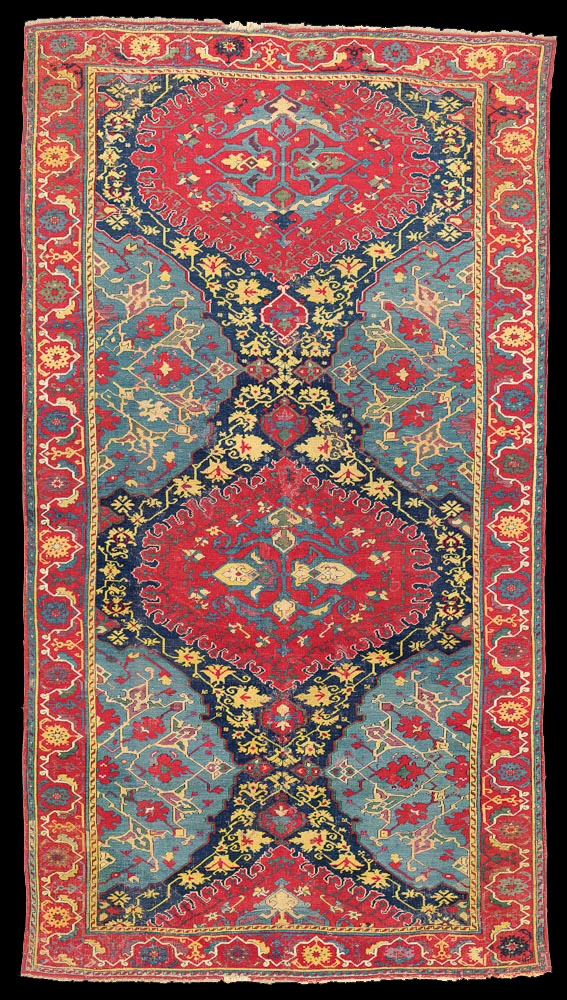|
A 'VARIANT' MEDALLION USHAK CARPET
WEST
ANATOLIA, LATE 16TH CENTURY
Price Realized £230,500 ($382,861)
Estimate £40,000 - £60,000
($66,240 - $99,360)
Sale Information
SALE 1519 —
Christies
ORIENTAL RUGS & CARPETS
8 April 2014
London, King Street
Lot 96
A VARIANT' MEDALLION USHAK CARPET
WEST
ANATOLIA, LATE 16TH CENTURY
Light touches of wear but mostly in very
good pile, scattered small repairs, overall very good condition
11ft.6in. x 6ft.4in. (348cm. x 193cm.)
Lot Notes
The earliest
Medallion Ushak carpets can be dated comfortably back into the fifteenth
century, particularly on the basis of comparisons with other media from
the Ottoman empire of that period (Carlo Maria Suriano, 'Oak leaves and
Arabesques', Hali 116, May-June 2001, pp.106-115). In his article Suriano
discusses a number of early examples of the group, many of which share
border features with each other, and also an elegance of drawing of the
main field, which make it clear why the design was so popular. One such
example is the magnificent Lefevre large Medallion Ushak, now in the
al-Sabah Collection, Dar al-Athar al-Islamiyyah, Kuwait, (Suriano, op.cit.
fig.21), which has a very similar border to the present lot.
Unlike early Persian carpet designs where the field is centred around a
medallion and enclosed by four quarter medallions, an idea that can be
directly tied with early Persian book covers, the designs of Ushak
Medallion carpets form an endless repeat pattern of alternating rows of
offset medallions (Kurt Erdmann, The History of the Early Turkish Carpet,
London, 1977, pp.36-39). Whilst the present carpet still retains one
single complete medallion just below the centre, all of the remaining
medallions are bisected at various points by the main border. The present
lot has three central red lobed medallions which have an unusual variant
central configuration of two mirrored palmettes which have been rotated on
a 90 degree angle and are enclosed above and below by two branches of
scrolling arabesque flowering vine. This same ornamentation is found on a
fragmentary 16th century carpet from East Anatolia originally from the Ulu
Mosque in Sivas and now in the Vakiflar Museum, Istanbul (Belkis Balpinar
and Udo Hirsch, Carpets of the Vakilflar Museum Istanbul, Wesel, 1988,
pl.47, pp.270-1). Whilst the drawing of the field design on that carpet is
more open and less elegant than the present lot, that carpet provides a
fascinating insight as to how a design, that was presumably seen on either
a late 15th or early 16th century carpet in West Anatolia, travelled
within a relatively short space of time to a weaving centre in the East of
the country. The light blue secondary medallions on the present lot are
also unusual and appear far less pointed than many which take their form
from the eight radiating petals of the open lotus flower, hence their name
'lotus' medallions. A very close comparable which has three complete red
medallions but which are more compressed in form than ours can be found in
the Österreichisches Museum für angewandte Kunst, Vienna, (Angela Völker,
Die Orientalischen Knüpfteppiche im MAK, Vienna, 2001, pl 15, pp.82-3) and
on a smaller early 17th century example which has the same field design
but different border, exhibited by Alberto Boralevi at Satirana, 1992
(Hali 66, December 1992, p.29, and p.158).
The border design on
the present lot of linked crenellated arches housing individual palmettes
beneath is found on the same 16th century East Anatolian carpet in the
Vakilfar Museum (referenced earlier). Interestingly it is a border that is
more commonly found on 'Star' Ushak carpets, (see Charles Grant Ellis,
Oriental Carpets in the Philadelphia Museum of Art, London, 1988 pl.23,
pp.68-9. and Friedrich Spuhler, Carpets From Islamic Lands, The al-Sabah
Collection, Kuwait, London, 2012, pp.45-9). The reciprocal arches allow
the weaver the possibility to create a bi-coloured ground often using blue
on the inner half and the same red ground as the field on the outer
section. The ground colour of the border on our carpet is a monochromatic
red, however the variety and exuberance of the colours within the details;
aubergine, fir-green, yellow, ivory, sky-blue and mid-blue are
particularly attractive. It is the number of colours and the variety of
ways in which they are used, as well as the overall design of this
beautiful carpet that suggest it was likely woven at the end of the
sixteenth century.

.jpg)
.jpg)
.jpg)
.jpg)
.jpg)
|


.jpg)
.jpg)
.jpg)
.jpg)
.jpg)